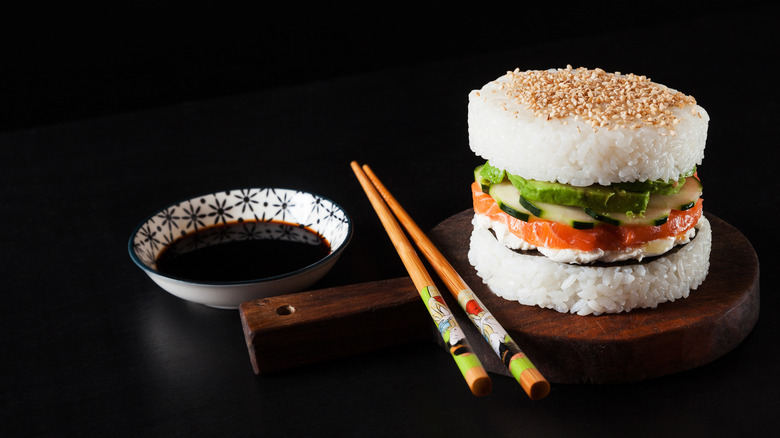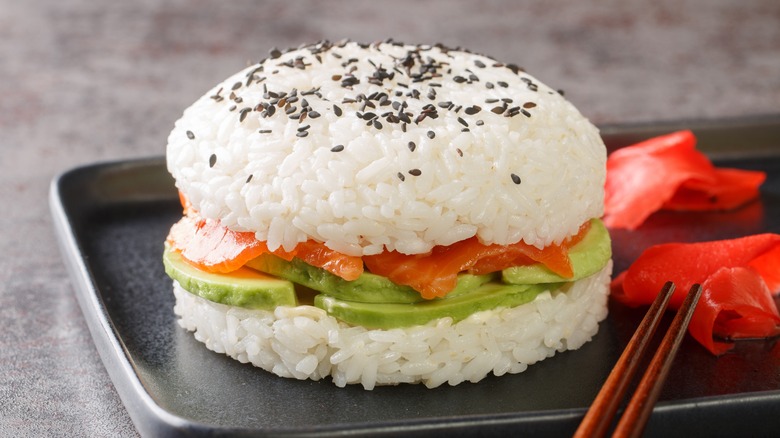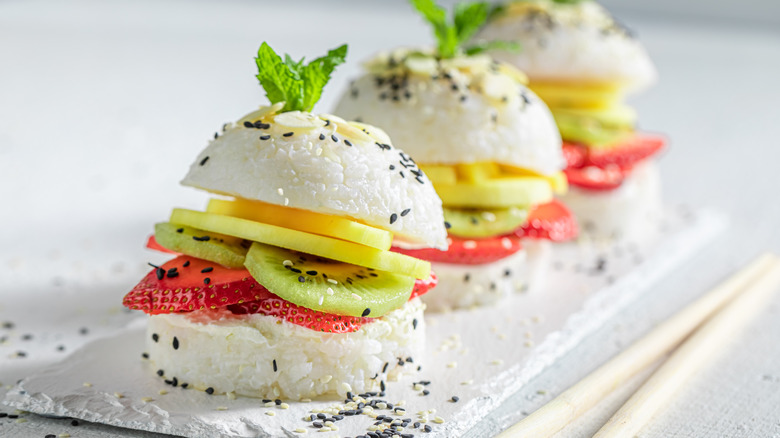The Sushi Burger Satisfies Both Cravings When You Can't Decide On A Dish
Sometimes you read the name of a food item that isn't what it sounds like – think prairie oysters, or head cheese. But other times, like now, the name means what it says on the tin. A sushi burger is exactly that, sushi formed into the shape of a burger.
Sushi already comes in many forms, but how did sushi burgers come about? Purportedly, it all started in the 1960s, when Satoshi Sakurada, a Japanese man working in Los Angeles, regularly dined at a California burger chain named Tommy's. He decided to bring this hamburger idea back to Japan and opened MOS Burger in 1972, with patties and toppings that fused Japanese culinary staples with an American mainstay, according to its website. In 1987, MOS launched the tsukune rice burger, which featured "buns" of compressed sushi rice disks, and a large, patty-fied tsukune, otherwise known as a Japanese chicken meatball.
The beauty of the sushi burger is simple: You can hold it and eat it like you would a more "traditional" take on the hamburger. At MOS, it's offered with fried seafood or grilled beef slices in place of a patty, essentially giving you a portable Japanese meal. You may also be able to find it in other fusion Japanese restaurants. However, the easiest way to enjoy a sushi burger — one that uses traditional sushi proteins of the sea-based variety — is to make it at home.
Making your own sushi burger
Since sushi burgers are a twist on the traditional Japanese dish, you aren't technically beholden to any conventional sushi rules. This leaves you free to create and eat any sushi burger that suits your fancy. A fun way to start is to think about the fillings of your favorite sushi roll or rice bowl, and from there, find inspiration to turn it into a version of your own personalized sushi burger.
Let's experiment by turning a salmon sushi roll into a sushi burger. The former's core constituent ingredients are cooked Japanese rice and sashimi-grade salmon, though you can add other complementary toppings as you see fit, like avocado and sesame seeds. First, shape cooked sushi rice into "buns" (with a dash of rice wine vinegar, which helps as a binding agent), and then lay the buns on a clean chopping board like you would hamburger bun halves. Arrange slices of salmon and avocado onto the rice "buns' and squeeze over some Japanese mayonnaise before closing the burger. Sprinkle sesame seeds on top for a bit of nutty flavor and crunch, and you've got yourself a sushi burger!
When using raw seafood for a sushi burger topping, remember to use the freshest sashimi-grade fish (or in the example above, sushi-grade salmon) you can find. The rice buns can also be grilled to help keep their shape and give a satisfying chew. The rice vinegar used to help your sushi rice stick also gives your "buns" a pleasant mild tang reminiscent of a proper sushi roll.
Sushi burger-adjacent ideas
Sushi burgers don't have to be limited to savory flavors. Fruit sandwiches are popular in Japanese convenience stores, and can be adapted to the sushi burger form. For filling, simply use slices of the freshest fruit available to you (mangoes and strawberries are deliciously appropriate here), along with a light layer of whipped cream. (It's almost like Thai-style mango with sticky rice, a decidedly burger-shaped version of the treat.)
There is another similar form of sushi burger known as onigirazu, sometimes called a "sushi sandwich." Though the sushi burger — at least the one invented by Satoshi Sakurada's MOS Burger — predates it by a few years, onigirazu first appeared in the "Cooking Papa" manga series in the '90s, and is essentially sushi whose components have been laid flat and wrapped with nori seaweed to keep all the fillings in. Usually served sliced in half, it presents like a sandwich, with visible starch and topping layers.
Food forms like the sushi burger remind us to play with our food as creatively as we dare, and have as much fun as we possibly can along the way. That being said, sushi tacos, anyone?


